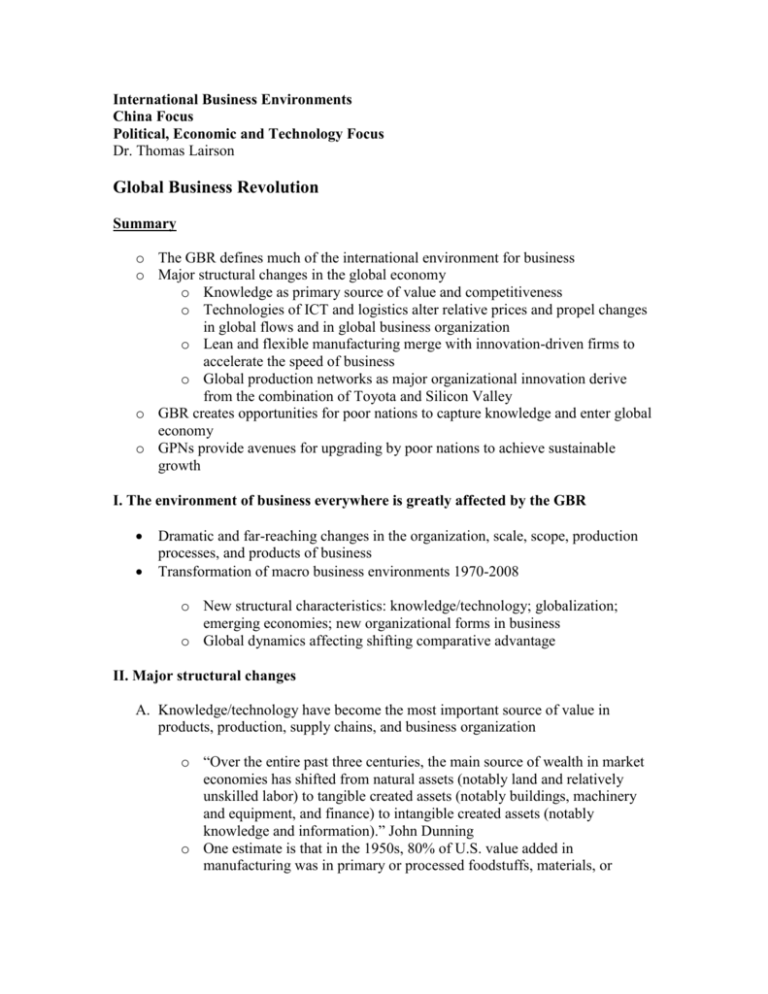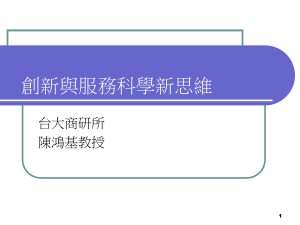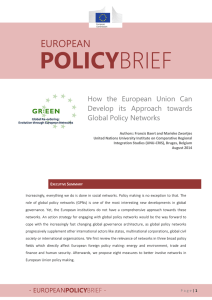Notes - MyWeb
advertisement

International Business Environments China Focus Political, Economic and Technology Focus Dr. Thomas Lairson Global Business Revolution Summary o The GBR defines much of the international environment for business o Major structural changes in the global economy o Knowledge as primary source of value and competitiveness o Technologies of ICT and logistics alter relative prices and propel changes in global flows and in global business organization o Lean and flexible manufacturing merge with innovation-driven firms to accelerate the speed of business o Global production networks as major organizational innovation derive from the combination of Toyota and Silicon Valley o GBR creates opportunities for poor nations to capture knowledge and enter global economy o GPNs provide avenues for upgrading by poor nations to achieve sustainable growth I. The environment of business everywhere is greatly affected by the GBR Dramatic and far-reaching changes in the organization, scale, scope, production processes, and products of business Transformation of macro business environments 1970-2008 o New structural characteristics: knowledge/technology; globalization; emerging economies; new organizational forms in business o Global dynamics affecting shifting comparative advantage II. Major structural changes A. Knowledge/technology have become the most important source of value in products, production, supply chains, and business organization o “Over the entire past three centuries, the main source of wealth in market economies has shifted from natural assets (notably land and relatively unskilled labor) to tangible created assets (notably buildings, machinery and equipment, and finance) to intangible created assets (notably knowledge and information).” John Dunning o One estimate is that in the 1950s, 80% of U.S. value added in manufacturing was in primary or processed foodstuffs, materials, or mineral products and 20% knowledge. In 1995, these ratios had changed to 30% and 70%. o Another estimate suggests the intellectual capital of firms is five to sixteen times as valuable as the physical capital of these same firms. o From 1975 to 1995, R&D expenditures rose at 3 times the rate of growth of manufacturing output in OCED countries. o “three-quarters of the value of publicly traded companies comes from intangible assets (based on knowledge), up from around 40% in the early 1980s.” Source: Economist, October 11, 2007 B. Technological changes began to alter dramatically the costs of three key elements of economic exchange after about 1960: communications, information, and the movement of people and goods. The changes led to new capabilities, to new products and processes and to the acceleration in the role of knowledge. In many ways, the current era of globalization is a result of these technological and related economic changes. This is promoted by major technological changes: Large and rapid declines in cost of creating, manipulating and distributing (on a global scale) information Moore’s Law Figure II Cost Comparisons for Information Production and Distribution 1970 1999 $7601 $0.17 $5257 $0.17 Cost of 1Mhz of processing power Cost of 1 megabit of storage $150,000 $0.12 Cost of sending 1 trillion bits of information Source: Pam Woodall, “Untangling E-conomics,” The Economist, September 21, 2000. Large and rapid declines in communication costs on a global scale: 35% decline per year for more than 40 years Large and rapid declines in cost of/increasing speed in delivery of products on a global scale – containerization i. Containerization prices for goods moving from Asia to the US dropped by 65% between 1972 and 1997. Kenney, 2004, 6. One measure of this last point is change in the cost of logistics and in the cost of inventory investment. Logistics and Inventory Costs in US 1980 1995 Inventory cost % of GDP 9% 4.3% Logistics cost % of GDP 17.2% 10.8% Source: Martin Kenney, “Introduction,” in Martin Kenney and Richard Florida, (eds.) Locating Global Advantage, Stanford: Stanford University Press, 2004, 5. o Technological changes lead to large and rapid increases in global economic transactions and cumulating variety of new global products Trade Financial transactions FDI Knowledge Global Production Networks Emerging Technologies Web 2.0 Nanotechnology Biotechnology o Globalization intersects with rapid increases in national institutional capabilities in some poor nations = emerging economies o 19th Century Globalization did not lead to growth in poor states o Late 20th Century Globalization: Open global markets and global flows of knowledge, technology and investment intersect with new capabilities of governments and firms in poor nations Japan post 1955 Asian Tigers China Brazil Russia India o Emerging economies create new markets, new production capabilities, new sources of global and local innovation, new sources of competition o Deep integration of economies across manufacturing, trade, product development, distribution, knowledge networks, investment, technology diffusion o Governments from advanced and emerging economies become central and essential players in globalization and growth C. Emergence of New Forms of Production and Organization Effects of Technological Changes o Increasing speed of new product and process development/shorter product cycles o Strategic alliances – knowledge sharing; risk sharing o Knowledge capture and application to innovation as main basis for competitive advantage New forms of TNCs o Ability to manage a global portfolio of complementary assets inside and outside of the firm o Firms and states as partners in creating complementary assets o Lean flexible manufacturing based on integrating global complementary assets o Global Production Networks - Intra-firm trade Intensifying global competition focused on innovation o Deeper global division of labor – finer specialization o Network forms of organization o Mobility of intangible assets – knowledge, technology, organizational skills, investment capital Global Production Networks (GPNs) What is a GPN? o A new institutional form in the global economy – a coordinated system of capabilities and products used to generate competitive advantages in global markets. o A new form for production and distribution that involves the fragmentation – through both horizontal and vertical disintegration – of the value chain into various elements or nodes of value-added capabilities. The geographic dispersal of production and the integration via ICTs Basic features of GPNs: o Fragmentation of value chain o Increased outsourcing of manufacturing and services o Computer-based interaction for production, logistics, design o Increased production speed o Expanding geographic of production and enhanced global integration o Creation of global supply base o Production processes that previously were feasible and cost effective only within a single firm (and in a single physical location) or within a nation and a small number of firms can now be reorganized into a wide array of specialized firms located across the globe in the most advantageous locations and with little regard for distance per se. o The GPN has a distinct structure of power and control, typically starting from one or more lead MNCs – or global system integrators (GSIs). These firms usually have the greatest knowledge and other resources – marketing, design, management, information, branding, market access – and whose core competency is to organize these resources to structure and integrate the value chain. o GPNs are the most prominent in firms with significant levels of knowledge intensity in production and/or product and where firms enjoy considerable economies of scale. o Composed of linkages among TNCs, national and local governments, local firms, research institutes, parastatal institutions, global research labs, universities (science, technology, and business units), consulting firms, government agencies, NGOs, and IOs. These linkages are composed of the exchange of products, strategic alliances, and exchanges of knowledge and technology. o The network is bound together by the actions of the GSI in relation to geographically dispersed firms and the states where they are located. This is accomplished through the creation of an information and logistics system to bind the network together, through foreign direct investment by the GSI (examples include Cisco Systems and/or contract manufacturers), through the sharing of knowledge and technology, and through support for the creation of institutional capabilities in the various states where nodes of production are located. The various nodes in the network are not all equal because differentiated connections to global markets and global knowledge networks exist across the network. The development of GPNs: GPNs a re a combination of lean production (Toyota) and the Silicon Valley networked firm model enhanced by advanced business technologies Gold Standard for Global Best Practice Toyota Production System Lean/Flexible/JIT manufacturing Quality control Knowledge-based innovation on shop floor Enhance and integrate knowledge across the organization Quality circles Application of information technology to permit the substitution of information for physical inventory and logistics New global standards for cost, quality and speed of production, ramp up time to market Build on the close relationships with its suppliers to “outsource” larger and larger parts of the automobile value chain Production based on actual demand not on forecasts System of knowledge-based organizational capabilities Mass customization – various market niches Batch production Silicon Valley Model Formed in the 1960s and 1970s Related to but different from Toyota Hewlett Packard/ Fairchild Semiconductor/ Intel Entrepreneurial risk-taking culture Venture capital culture – trial and error Knowledge-sharing culture based on belief in technology Academic culture of openness and give and take Informal information networks Many SMEs of specialist suppliers and service providers Differentiated firms – specialization; fragmented supply chains Premium on innovation; early versions of open innovation Networks of firms, suppliers, services, universities, research labs, VC, business associations Cooperation in JVs and strategic alliances Flat organizations Core competency/outsourcing Network systems spreads risks and costs; draws on differentiated and distributed knowledge/innovation capabilities Application of information technology to permit the substitution of information for physical inventory, logistics, collocation of teams (CAD, CAM, SCM, ERP, EDI) Emergence of the systems integrator firm (lead firm; flagship firm) Development of Lean and Flexible Organizations Walmart – Lean plus SV Dell Cisco Impact of Global/Regional Production Networks Rapid economic growth in selected nations Creation of a global supply base Globalization of innovation – process New knowledge centers – globally dispersed Regional production and knowledge specialization systems drive regional dynamics of flying geese Knowledge networks expand and deepen over larger geographic space through exchange of increasingly richer information and data Component modularity and process modularity Mechanism for local and national upgrading across value chain Global Dynamics of change Over time, which nations industrialize and which do not? Political Economy shapes the direction and timing of shifting capabilities for industrialization from one country to another Basic dynamic is industrialization starts in lower cost states but the process of economic growth leads to rising costs as incomes increase with success Industrialization starts in labor-intensive industries drawing workers from agriculture. Eventually, these workers are employed and the labor surplus turns into a labor shortage. Labor costs rise and firms react by adopting more capital-intensive production. This raises labor costs more as workers become more skilled. A second reaction in an age of globalization is to shift laborintensive parts of the value chain to other nations with lower labor costs and sufficient hard and soft infrastructure. Advanced dynamic is need for technology savvy, adaptive, upgrade capable, innovation-based capabilities in emerging economies with lower costs Dynamic is driven by TNCs looking for best locations for FDI Track 1: Low cost labor combined with governmental effectiveness in creating infrastructure, maintaining commitment to liberalization, improve capabilities for upgrading through time (labor intensive, mature industries, slow tech change) Track 2: Drawn to local clusters with combination of labor costs and cluster specializations in innovation (knowledge worker intensive, higher tech, rapid tech change, flexible manufacturing) Locations that attract FDI and the knowledge and technology and global market access are those nations able to assemble the low wages with complementary assets in infrastructure and national policy Sustained success involves achieving global market share in products, upgrading to achieve global quality Sustained success also involves the capacity for upgrading of capabilities and moving up the value chain. Sustained success leads to rising costs: TNCs and national firms look for new lower cost locations with the right combination of low wages and complementary assets Examples: US/Western Europe Japan to Japan/US to Japan 1890-1920 Korea and Taiwan 1915-1945 to Asian Tigers 1965-1997 HK, Taiwan to China 1980-2008 Korea, Japan to Vietnam 1995-2008 China Vietnam 2005 - ? to










